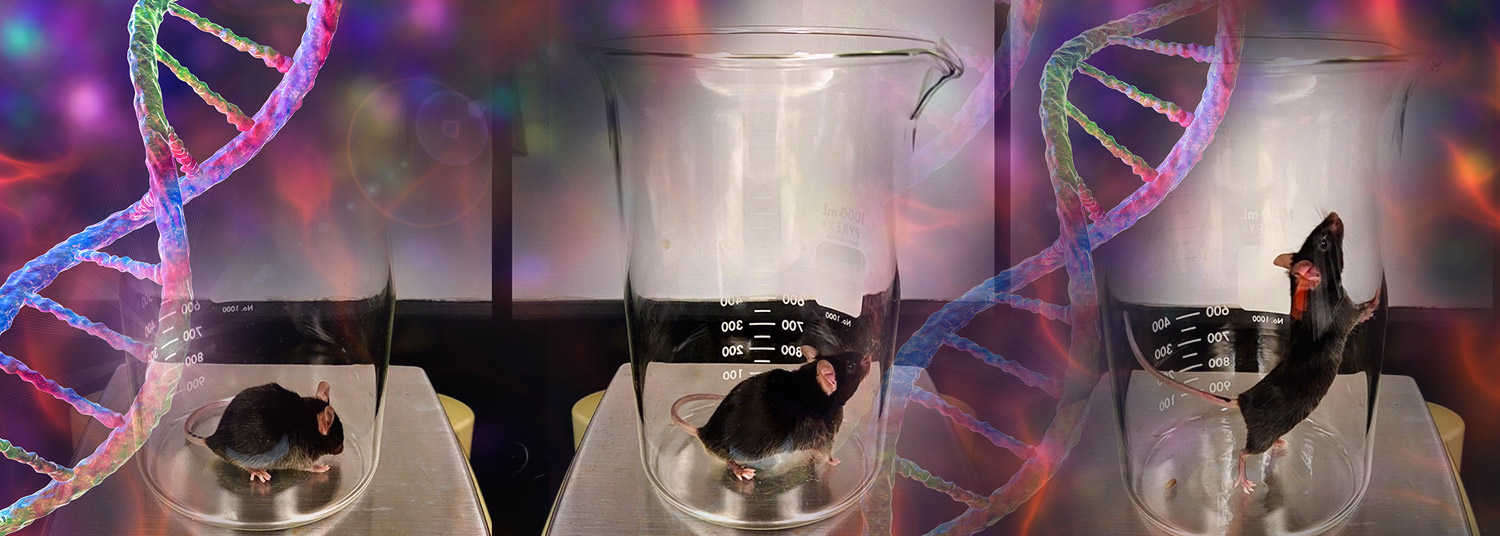August 02, 2022 | Cooper Roache
University of Maryland School of Medicine Study Findings Provide a New Understanding of the Disease Mechanism and Treatment Options
 Three genetic alterations associated with a rare seizure and a movement disorder primarily found in children were successfully mirrored in mice and their symptoms treated, in a new study from a University of Maryland School of Medicine (UMSOM) researcher, Andrea Meredith, PhD, Professor of Physiology and her collaborators.
Three genetic alterations associated with a rare seizure and a movement disorder primarily found in children were successfully mirrored in mice and their symptoms treated, in a new study from a University of Maryland School of Medicine (UMSOM) researcher, Andrea Meredith, PhD, Professor of Physiology and her collaborators.
The disorder – KCNMA1-linked channelopathy, named after the affected gene – is associated with involuntary collapsing episodes, in which patients slump over from loss of posture and muscle tone. Although these episodes are brief, they can occur hundreds of times per day, putting patients at risk of serious injury. The disorder can cause severe developmental delay and has been difficult to treat, with researchers lacking an explanation as to how this disease affects the brain and body.
"Most individuals with KCNMAl-linked channelopathy did not inherit the disorder from their parents," said Dr. Meredith, senior author of the paper. "Without this inheritance pattern, it is difficult to identify the major symptoms of the disorder and the KCNMAl gene changes that produce these symptoms. Introducing patients' mutations into mice provides answers to these questions."
Dr. Meredith said that once they establish the mechanism behind these symptoms they will be ready to test therapies that can treat the disorder.
The findings were published online on July 12, 2022, in eLife.
Along with collapsing episodes, people who have mutations in the KCNMA1 gene can experience seizures and developmental delay. The manner in which genetic changes produce these symptoms is currently unknown. However, the researchers know that the KCNMA1 gene encodes an ion channel, which moves charged potassium through cells to produce electrical signals in neurons and muscles, controlling muscle movement. For KCNMA1 mutations found in patients, a single DNA letter is exchanged for another incorrect one. The researchers believe these KCNMA1 patient mutations change how ion channels function, which affects the brain’s ability to control muscle movements.
 To test this idea, the researchers genetically engineered several groups of mice, in which each group carried one of three different KCNMA1 patient mutations, all associated with the disorder. Two of these mutations occur in about half of patients, while only one known patient carries the third mutation.
To test this idea, the researchers genetically engineered several groups of mice, in which each group carried one of three different KCNMA1 patient mutations, all associated with the disorder. Two of these mutations occur in about half of patients, while only one known patient carries the third mutation.
"In neurological research, mouse disease models help us better identify specific aspects of brain activity that may cause seizures or movement problems in patients," said author Peter Crino, MD, PhD, the Dr. Richard and Kathryn Taylor Professor and Chair in UMSOM’s Department of Neurology.
While none of the mice carrying KCNMA1 patient mutations had spontaneous seizures that occur in some patients, two of the mutations caused mice to develop them faster than healthy mice when given a seizure-inducing drug. These mice were then tested to see if they had a movement disorder. When stressed, these same mutant mice had a hunched posture and did not move for short time periods, similar to the slumping during the patients’ collapsing episodes. However, mice carrying the third mutation did not develop seizures faster or move less than mice with normal ion channels when stressed.
Next, the researchers gave the group of mice with the most severe movement disorder a stimulant called dextroamphetamine, commonly prescribed as an ADHD medication. When the researchers tested the mice again after giving the stimulant, they stayed more active with fewer episodes of less mobility.
"Patients with the same KCNMAl mutation also respond positively to stimulants," said Dr. Meredith. "Since this drug works to decrease the immobility episodes in mice, we can follow its effects to understand the mechanisms."
Because the mutant mice displayed the main symptoms of the disorder, the researchers wanted to explore what was happening at a molecular level. The researchers first found that KCNMA1 patient mutations change how the ion channels behaved in cells that were in a dish. Next, the researchers recorded the electrical signals directly from mouse neurons. The two mutations that caused less movement in mice increased the ion channel current, causing the neurons to produce more electrical signals as compared to mice with normal ion channels. The third mutation, which decreased ion channel current, did not show a difference in electrical signals in neurons. However, the researchers hypothesized that both types of changes in how the channels open may create the patient symptoms in a complex symphony of neuron and muscle miscommunication.
 Dr. Meredith and her laboratory’s findings have garnered interest for further drug validation. She is collaborating with researchers at the National Human Genome Research Institute to design a clinical trial evaluating stimulants to treat the KCNMA1-linked channelopathy disorder.
Dr. Meredith and her laboratory’s findings have garnered interest for further drug validation. She is collaborating with researchers at the National Human Genome Research Institute to design a clinical trial evaluating stimulants to treat the KCNMA1-linked channelopathy disorder.
"We want to help as many patients as possible by identifying those that will respond to this treatment," said Dr. Meredith.
“A future clinical trial could further answer additional questions about how KCNMA1 mutations may cause the main patient symptoms,” said Mark T. Gladwin, MD, Vice President for Medical Affairs, University of Maryland, Baltimore, and the John Z. and Akiko K. Bowers Distinguished Professor and Dean, University of Maryland School of Medicine. “Having that knowledge would pave the way for new potential treatments for this rare and debilitating disorder.”
Other authors of this paper included Post-doctoral Fellow Su Mi Park, PhD; Laboratory Technician Cooper Roache, MS; Phillip Iffland II, PhD, Assistant Professor of Neurology;
Post-doctoral Fellow Hans Moldenhauer, PhD; Graduate Student Katia Matychak, PhD;
Graduate Student Amber Plante, PhD; and Research Assistant Abbey Lieberman, all from the University of Maryland School of Medicine.
The research is supported by grants from the National Heart, Lung, and Blood Institute (R01-HL102758), the National Institute of General Medical Sciences (T32-GM008181), the S&R Foundation Ryuji Ueno Award for Ion Channels Research, the National Institute of Neurological Disorders and Stroke (NS114122), and the University of Maryland, Baltimore, Institute for Clinical & Translational Research (voucher 376), which is funded by a Clinical Translational Science Award from the National Center for Advancing Translational Sciences (1UL1TR003098).
About the University of Maryland School of Medicine
Now in its third century, the University of Maryland School of Medicine was chartered in 1807 as the first public medical school in the United States. It continues today as one of the fastest growing, top-tier biomedical research enterprises in the world — with 46 academic departments, centers, institutes, and programs, and a faculty of more than 3,000 physicians, scientists, and allied health professionals, including members of the National Academy of Medicine and the National Academy of Sciences, and a distinguished two-time winner of the Albert E. Lasker Award in Medical Research. With an operating budget of more than $1.3 billion, the School of Medicine works closely in partnership with the University of Maryland Medical Center and Medical System to provide research-intensive, academic and clinically based care for nearly 2 million patients each year. The School of Medicine has nearly $600 million in extramural funding, with most of its academic departments highly ranked among all medical schools in the nation in research funding. As one of the seven professional schools that make up the University of Maryland, Baltimore campus, the School of Medicine has a total population of nearly 9,000 faculty and staff, including 2,500 students, trainees, residents, and fellows. The combined School of Medicine and Medical System (“University of Maryland Medicine”) has an annual budget of over $6 billion and an economic impact of nearly $20 billion on the state and local community. The School of Medicine, which ranks as the 8th highest among public medical schools in research productivity (according to the Association of American Medical Colleges profile) is an innovator in translational medicine, with 606 active patents and 52 start-up companies. In the latest U.S. News & World Report ranking of the Best Medical Schools, published in 2021, the UM School of Medicine is ranked #9 among the 92 public medical schools in the U.S., and in the top 15 percent (#27) of all 192 public and private U.S. medical schools. The School of Medicine works locally, nationally, and globally, with research and treatment facilities in 36 countries around the world. Visit medschool.umaryland.edu
Contact
Vanessa McMains
Director, Media & Public Affairs
University of Maryland School of Medicine
Institute of Human Virology
vmcmains@ihv.umaryland.edu
Cell: 443-875-6099

